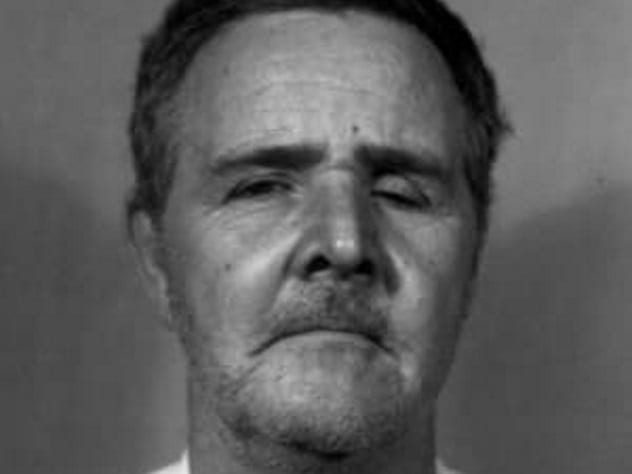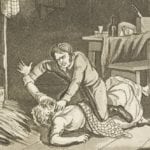 History
History  History
History  Weird Stuff
Weird Stuff 10 Fascinating Things You Might Not Know About Spiders
 Food
Food 10 Everyday Foods You Didn’t Know Were Invented by the U.S. Military
 History
History 10 Odd Things Colonial Americans Kept at Home
 Weird Stuff
Weird Stuff 10 Superstitious Beliefs That Once Consumed Entire Cultures
 History
History 10 Bizarre Friendly Fire Incidents in Military History
 Technology
Technology 10 Modern Technologies That Accidentally Imitate Ancient Magic
 Mysteries
Mysteries 10 Mysteries of the Human Genome
 Weird Stuff
Weird Stuff 10 Things So Rare They’ve Only Been Found Once
 History
History 10 Legends Whose Last Moments Undid Their Glory
 History
History 10 Great Escapes That Ended Right Back in Captivity
 Weird Stuff
Weird Stuff 10 Fascinating Things You Might Not Know About Spiders
 Food
Food 10 Everyday Foods You Didn’t Know Were Invented by the U.S. Military
Who's Behind Listverse?

Jamie Frater
Head Editor
Jamie founded Listverse due to an insatiable desire to share fascinating, obscure, and bizarre facts. He has been a guest speaker on numerous national radio and television stations and is a five time published author.
More About Us History
History 10 Odd Things Colonial Americans Kept at Home
 Weird Stuff
Weird Stuff 10 Superstitious Beliefs That Once Consumed Entire Cultures
 History
History 10 Bizarre Friendly Fire Incidents in Military History
 Technology
Technology 10 Modern Technologies That Accidentally Imitate Ancient Magic
 Mysteries
Mysteries 10 Mysteries of the Human Genome
 Weird Stuff
Weird Stuff 10 Things So Rare They’ve Only Been Found Once
 History
History 10 Legends Whose Last Moments Undid Their Glory
10 ‘Real’ Serial Killers Who Never Existed
Serial killers have long been the focus of ghoulish fascination in the minds of the public. True crime readers experience the vicarious thrill of walking in the minds of vicious murderers, and Listverse may have published a few serial killer lists in the past.
For most of us, this is as a harmless, if macabre, look at the dark side of humanity. Some people, however, become obsessed with the idea of either discovering a serial killer or, more disturbingly, of becoming one. Here, we look at ten serial killers who turned out to be not quite real.
10 Lucian Staniak

Lucian Staniak was a Polish serial killer nicknamed the Red Spider. He murdered multiple women between 1964 and 1967. After each murder, he wrote letters in his own blood, taunting the police for their inability to catch him. Eventually, he left a clean set fingerprints on a bottle at the scene of the rape and murder of an 18-year-old student, which was remarkably accommodating of him.
Staniak was arrested and explained that he was driven to murder to avenge his parents and sister, killed in a car accident, because their killers had never been brought to justice. He pleaded guilty to the murders of 20 women and was sentenced to death, though this was commuted to life in an insane asylum.[1]
All of which, it turns out, is complete rubbish. Staniak did not exist, the murders did not happen, and no one was ever prosecuted for them.
It is thought that Mr. Staniak may have been a figment of the imagination of true crime writer Colin Wilson, who wrote the first known “account” of the Red Spider’s career. This account was accepted as fact and circulated widely until researchers working on a biopic of the Red Spider and his crimes were forced to conclude that he had, in fact, never existed.
9 Sweeney Todd

There has long been controversy about whether or not Sweeney Todd was a real person. The Demon Barber of Fleet Street supposedly slit his customers’ throats with a razor and gave the bodies to his lover, Mrs. Lovett, to be turned into pies. Todd was born in 1756 and learned his trade in Newgate Prison, where he was jailed for petty theft
His first victim was a man with whom he had argued, and after the easy disposal of his body, Todd is supposed to have developed his “trick chair,” which he used on wealthy customers foolish enough to attend his premises alone. When he kicked the lever, the chair would tip through a trap door to the cellar, whereupon Todd would slit their throats and strip the meat from their bones to make pie filling.
Sweeney Todd and Mrs. Lovett were arrested after the number of missing sailors in need of a shave in the area aroused suspicion. Mrs. Lovett confessed immediately before committing suicide. Todd went on trial in 1801, accused of the murder of a single sailor who had been on his way to deliver a (very) large string of 16,000 pearls to a pawnbroker. The sailor, it seems, decided to stop off at Sweeney Todd’s emporium for a haircut and a shave on the way. When the premises were searched, police found belongings from 160 other people, suggesting that Todd may have been the most prolific killer ever.
All of this sounds thrilling, but, unfortunately, none of it can be proved. Barbers at that time were sometimes also surgeons and grave robbers and did, therefore, have a less-than-wholesome reputation. They could also perform tooth extractions, bloodletting, and, disturbingly, enemas.
However, there is no record of Sweeney Todd’s arrest, trial, or hanging, which supposedly happened in 1802. There is no report of any other barber committing multiple murders. Nor are there any newspaper archives of concern for missing sailors or strange-tasting pies.[2]
But it does make for a good musical.
8 The Phantom Of Heilbronn

In 2009, German authorities offered a €300,000 reward for the capture of “the woman without a face” who had left traces of her DNA at murders and major crime scenes for over 15 years, including the murder of a police officer in Heilbronn.
Investigators of the Heilbronn murder were shocked to discover that DNA found at the scene matched genetic material from other dozens of other cases. The unknown Phantom of Heilbronn, as she was was dubbed, had committed crimes all across Europe, ranging from murder to burglary and vehicle theft. And her crime spree continued. Three corpses were dragged from a river near Frankfurt. Two men were convicted of their murder, but traces of the phantom’s DNA were also found in the car. If the men knew who she was, they weren’t telling.
The first sample from the serial killer was taken from the rim of a teacup belonging to a woman strangled with a piece of wire. The DNA was then traced to the bullet in a gun fired by someone else. It was found in cars, on used syringes, and on murder weapons galore.
But, despite the growing evidence, the police were stumped. They launched an intensive manhunt to find the woman, who was clearly dangerous. Late in 2009, however, they finally apprehended their suspect, only to find that the Phantom of Heilbronn was, in fact, an entirely innocent woman working in the factory that produced their DNA-testing kits.[3]
7 The Halifax Slasher

In 1938, two mill workers in Halifax, England, were attacked by a knife-wielding madman who was soon dubbed the Halifax Slasher. Over the following nine days, more and more women fell victim to the slasher. Vigilante groups began to patrol the streets to protect their women and beat up anyone who looked suspicious.
Scotland Yard was called in to catch the miscreant before someone was killed by the lynch mobs. As they interviewed “victims,” it soon became clear that the majority of their wounds had been self-inflicted. The events in Halifax were, it seemed, a classic case of mass hysteria.
But what of the original two victims? They had given a clear description of the slasher, down to the bright buckles on his shoes. They had blood streaming from wounds in their heads. Surely, their accounts were real? No. Apparently, they had made it up, too.[4]
6 The Mad Gasser Of Mattoon

The Mad Gasser of Mattoon had a peculiar way of attacking his victims. Most serial killers commit their crimes over a number of years; he attacked 34 people over two weeks in 1944. Most serial killers like to watch their victims die; he attacked from a safe distance. Most killers favor guns, knives, or blunt objects. As his name suggests, however, the Mad Gasser preferred the humble domestic oven.
Some of the victims in Mattoon, Illinois, became ill; others found that they were paralyzed. Luckily, no one actually died. No trace of gas was found in the houses, and there were no clues. Despite this, the newspapers ran stories of mad gassers and described the victims’ symptoms in lurid detail. Over the next few days, more and more people, mostly those who had read the newspaper articles, fell victim to the gasser. Police continued to find no clues, nor any gas anywhere other than where it should have been.
They did find a woman who came home to find a piece of cloth on her doorstep, which caused a burning sensation in her throat when, for reasons unknown, she put it to her face and inhaled. She also found a skeleton key and a stick of lipstick. Convinced that the gasser had been interrupted in the middle of the attack, investigators analyzed the cloth, but no trace of toxic substances could be found. The key turned out to be an ordinary key, and the lipstick was just lipstick.
There seemed to be no motive for the attacks. No one had been assaulted, and none of the houses had been robbed. The police concluded that there never had been any attacks, and the crimes were the result of mass hysteria brought on by inflammatory reporting of the first case. The police also suggested that the original case of poisoning might, just possibly, have been caused by chemical emissions from the factory next door.[5]
5 Thomas Quick

Thomas Quick was once considered Sweden’s most notorious serial killer, having confessed to over 30 murders, though he was tried and convicted of only eight. He claimed to have tortured, raped, killed, and even eaten some of his victims, including a nine-year-old girl. He was convicted on his confessions alone, with no supporting evidence, despite some major discrepancies, such as the fact that his semen did not match that found on one of his victim’s bodies.[6]
He obligingly helped police to clear up their cold cases, confessing to everything put before him. He was quite often hazy on the details, saying one victim was blonde, when she was dark-haired, and forgetting where he had abducted her.
Quick confessed to killing a teenage boy in 1964, when he was aged only 14, though witnesses placed him 400 kilometers (250 mi) away taking his first communion at the time. There was no DNA evidence, no murder weapon, and no eyewitnesses to his crimes. Quick mentioned 24 different places where he had committed murders, dismembered bodies, or buried remains, but not a single trace of DNA was ever found in any of them.
All his confessions were pure fabrication. It’s possible the fact that he was drugged on benzodiazepines throughout all of his police interviews affected his judgement. It was only when Quick’s medical team changed, and his medication was reduced, that he stopped confessing to murders.
He was eventually acquitted of all eight murders and released. Quick, who changed his name to Sture Bergwall, had always had a history of mental problems and was already in an institution when he confessed to his first crime. This, apparently, did not tip the police off.
4 Joe Scafe

Joe Scafe is not a serial killer. In fact, Joe Scafe is not even a person. He is the invention of Professor T. Mills Kelly and his students at George Mason University, who created him to test the theories they had learned in their history course, which was called Lying About The Past and examined the unreliability of historical accounts.
Using real newspaper archives, students identified four women who had been murdered in New York between 1895 and 1897. They created Wikipedia pages for the victims using factual information. Then they fabricated a story of the discovery of a trunk which appeared to show that an elderly relative, one Joe Scafe, was the serial killer responsible.
The story of the “gruesome find” was posted on online media sites, and visitors were soon linking the contents of the trunks to the Wikipedia pages. For a while, it seemed that the Internet had caught a killer. It didn’t take long, however, for the hoax to be discovered, as all the Wikipedia pages had been created at the same time.[7]
Nice try.
3 Henry Lee Lucas

Henry Lee Lucas very possibly was a serial killer, and he still stands convicted of 11 murders. No one will ever know for sure how many people he killed, though, because he confessed to having committed between 600 and 3,000 murders, depending on which reports you believe, some of which he couldn’t possibly have done.
He was condemned to death for the killing of an unidentified woman in Texas in 1979. There were no witnesses to the crime and no physical evidence of any kind, but Lucas was said to have confessed to her murder, even though his work records and a cashed paycheck indicated that he was in Florida at the time of her death. So flimsy was the evidence against him that even the governor of Texas was troubled. George W. Bush presided over the executions of 152 people during his terms as governor, but he commuted Lucas’s sentence to life in prison. Lucas was the only person whose sentence was commuted by Governor Bush.[8]
Despite this, Henry Lee Lucas was a violent man. He had already served 15 years in prison for beating his mother to death. He attributed his many confessions to tranquilizers and to the nice meals he was fed by police while he was confessing. He died of a heart attack in prison in 2001.
2 Wearside Jack
Between 1975 and 1980, the Yorkshire Ripper brutally killed 13 women. The police investigation was concentrated in Yorkshire, scene of most of the attacks, and investigators tried desperately to establish a pattern for the murders and a profile of the killer. In 1978, they received a letter from the killer, which they believed gave them an insight into the mind of the murderer.
Two more letters followed. And finally, a tape recording of the Ripper himself, speaking directly to the lead investigator, George Oldfield. The tape taunted the officer with his failure to capture him.
“I have the greatest respect for you George, but Lord! You are no nearer catching me now than four years ago when I started. I reckon your boys are letting you down, George.”
The police finally had a solid clue to work on. The Yorkshire Ripper was not, after all, from Yorkshire, but from Wearside, in the North East of England. Dialect experts were brought in to analyze the accent and were able to narrow the search area. The investigation team changed the focus of their search, and thousands of men from that area were interviewed, without success.
When the Ripper was finally caught, however, Peter Sutcliffe turned out to have a Yorkshire accent, after all. Wearside Jack was a hoaxer who had caused major disruption to the investigation. Most disturbingly, Peter Sutcliffe had been interviewed by police but had been released because his accent did not match that of the man on the tape, and he went on to kill again.
The identity of Wearside Jack was unknown until 2006, when John Humble, an unemployed alcoholic with no connection whatsoever to the Yorkshire Ripper, admitted making the tape as a prank. He was sentenced to eight years in prison.[9]
1 Andrew Scott Haley

In 2009, Andrew Scott Haley posted a video online claiming he had killed 16 people and inviting viewers to solve clues he had given them to the location of the bodies. He promised to reveal his true identity if they could solve the puzzle, which all seems like a harmless murder mystery game, except that Haley made the mistake of using the details, though not the names, of real murder victims, leading police to believe that he was the actual killer.
Hundreds of man-hours were spent chasing “catchmekiller,” as he named himself online. When he was finally caught, it became evident that Haley was not a murderer at all but a man with a computer and a dubious sense of humor. He was charged with making false statements, despite the fact that he had never named any of the people he had claimed to have killed and had not made these statements to the police.
Haley was sentenced to two years on a work release program. His legal team appealed the conviction on the grounds of freedom of speech.[10]
Ward Hazell is a writer who travels, and an occasional travel writer.
Read about more not-so-real crimes on 10 Shocking Cases Of People Who Faked Their Own Abductions and 10 Egregious Hate Crime Hoaxes.





![10 Creepiest Photos Of Victims Taken By Serial Killers [DISTURBING] 10 Creepiest Photos Of Victims Taken By Serial Killers [DISTURBING]](https://listverse.com/wp-content/uploads/2018/09/Regina-Kay-Walters-featured-2-150x150.jpg)


